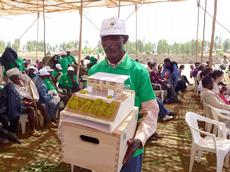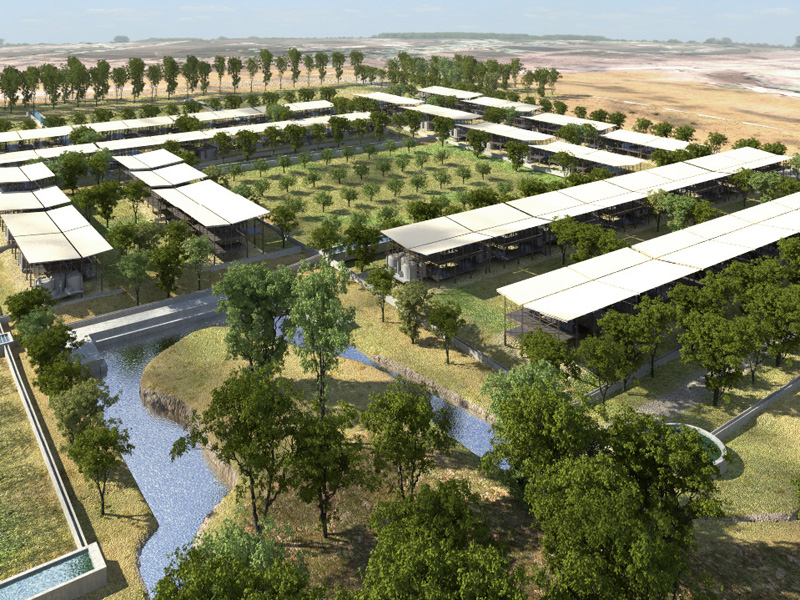Model city celebrates topping-out ceremony
In Ethiopia, over 1,000 people a day stream to Addis Ababa from the surrounding regions in search of a better life. In order to stem the exodus, ETH-Zurich architects are developing new cities for the rural population. The first “NESTown” recently celebrated its topping-out ceremony.

Ethiopia is under pressure. In less than thirty years, the population of the East African nation has doubled to ninety-one million. The situation has especially reached a critical level in the cities. Every day, hundreds of farmers leave their homes in the country in the hope of finding a better life in the centres. The majority are drawn to the capital Addis Ababa, where they mostly end up in home-made huts fashioned out of plastic sheets, wooden boards and corrugated iron without any sanitation or electricity, with no job or income.
In order to counter this development and improve the standard of living for the rural population, emeritus professor of architecture from ETH Zurich Franz Oswald initiated the urban development project “NEST” (New Energy Self-Sufficient Town) together with NESTown Group. It is intended to be a prime example of what environmentally and socially compatible settlements with a high level of self-sufficiency might look like outside Addis Ababa. The concept of NESTowns is an alternative to the customary form of urbanisation and the concentration of knowledge and infrastructure in semi-urban centres should open up new prospects for the rural population. The first NESTown recently celebrated its topping-out ceremony.
The idea of the “rural city” is that it is built by the inhabitants themselves based on varied and efficiently organised agriculture, including the corresponding infrastructure for a water supply and hygiene. “Ecology, energy, exchange and education are the driving forces behind the city,” says Oswald, who has been involved in the collaboration between Ethiopia and Switzerland for many years. Moreover, according to the professor, a NESTown is organised cooperatively.
Field research on the Blue Nile
The first town, which currently exists as a shell, is called BuraNEST and lies on Lake Tana, the headwaters of the Blue Nile about 350 kilometres from Addis Ababa as the crow flies. It serves as a model for hundreds of other centres that are planned by the Ethiopian government in years to come. At the same time, it is an object of research and co-funded as such by the Department of Architecture at ETH Zurich. A year after the first stone was laid back in 2010, for instance, a workshop was held at the Singapore-ETH Centre for Global Environmental Sustainability.
In the spring of 2012 construction work got underway on the city layout of BuraNest – with streets, a bridge, a tree nursery, a town square for community events and the so-called urban development hut or “Town Factory” – a model building for a so-called rainwater unit: a row of house for eight to sixteen housing units, on the roof of which rainwater is collected before being conducted into cisterns for storage.
Population has say from the word go
According to Oswald, it is important that no longer solely the authorities point the way; instead, urban development should be backed and co-managed by the population on an equal footing. In doing so, traditional values should be taken into consideration just as much as new, current approaches and viewpoints.
“The biggest challenge was to win the trust of the local population and ultimately support and develop this new-found self-confidence,” explains the emeritus professor. He sees himself and his team in the role of catalyst and moderator. The success of the project proves him right: ninety of the total 200 households in Close One, the first urban quarter, have already joined the cooperative, which was founded on the occasion of the topping-out ceremony. “That’s what we call a surprising, happy success.”
On the part of ETH Zurich, the staff of ETH Sustainability also made a sizeable contribution towards the successful outcome, stresses Oswald. The coordination office for the university’s sustainability activities made the exchange between Ethiopian and Swiss students and faculty members of ETH Zurich and Addis Ababa University possible in the first place and thus promoted the sustainable transfer of knowledge between the two countries. As a result, ETH Zurich has made a considerable contribution towards solving pressing global problems in Ethiopia.









READER COMMENTS